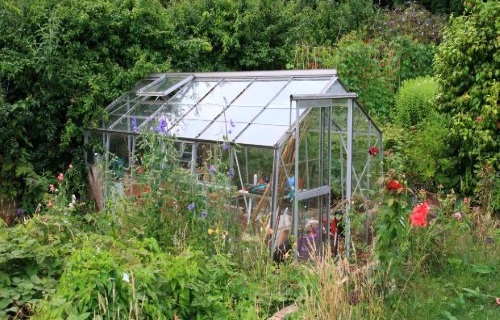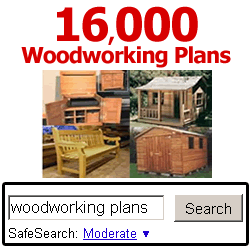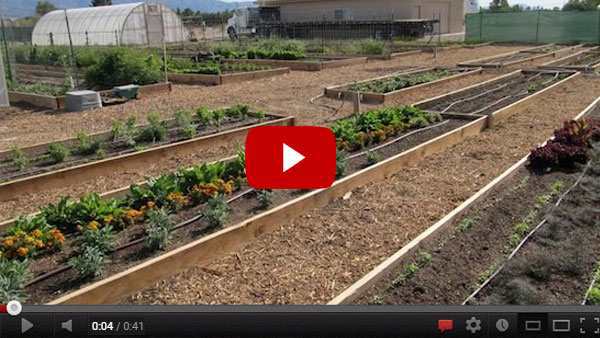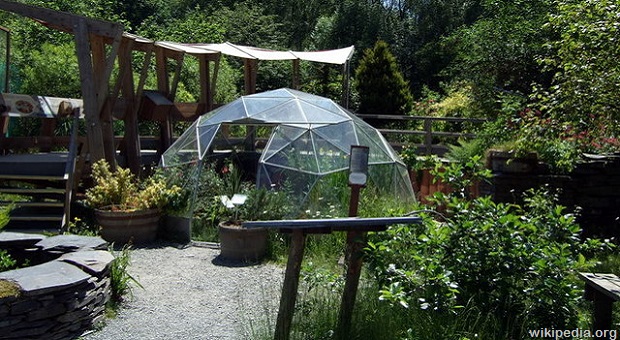Self Sufficient Greenhouse
Greenhouse Gardening [Part 1]
With skyrocketing prices at the grocery store and an unstable economy, it’s no surprise people are turning back to the ways of their grandparents and great-grandparents. Self sufficiency is needed now more than ever, and a greenhouse can provide fresh, healthy food for families virtually year round.
In the case of a natural disaster, pandemic, or even a government collapse, going to the grocery store may not be an option. Being prepared with a convenient source of healthy food can mean the difference between life and death, and a greenhouse can make all the difference when it matters most.
A greenhouse works by greatly increasing the growing season for a variety of vegetables. It does this by controlling temperatures, light, and even humidity. Although greenhouses increase the amount of time a vegetable can grow, vegetables still need to be grown around the time of their proper seasons in traditional greenhouses.
Rotating what vegetables are growing based on their seasons means a family can have a variety of food year round. For example, during the winter months broccoli and cauliflower grow great, while summer can provide cucumbers, lettuce, and eggplants. The variety of vegetables changes with the seasons so families will always have healthy options available.
Before picking out a greenhouse, it’s important to look at both the pros and cons of the various structures. Listed below are different types of structures with their benefits and drawbacks. Determining which one best fits a given situation.
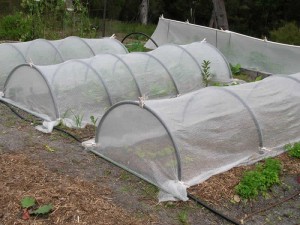 Hoop House
Hoop House
A hoop house is a relatively basic form of a greenhouse. Using limited materials, this type of greenhouse has a wooden framework placed on the ground in a rectangular shape and arched “hoops” starting at one side and going to the other.
A variety of covers can be used, such as a shade fabric or polyethylene film. Although it looks like a quonset hut in design, it is much more basic. The benefits to a hoop house are the low cost, relatively easy set up and the ability to move them as needed.
Since the hoop house can only minimally control light and temperature, it is used mostly for crops that are hardier and less susceptible to temperature fluctuations. Vegetables such as broccoli or cabbage grow well in a hoop house, but for more delicate crops, this type of structure wouldn’t be recommended.
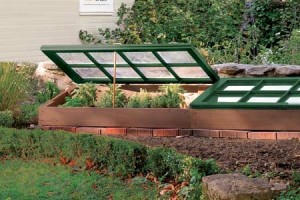 Cold Frame
Cold Frame
A cold frame greenhouse is much like a hoop house and offers the same benefits, with the exception of being mobile. The ground framework is put partially into the ground, rendering it difficult to move. The hoops that hold up the covering are shorter than in a hoop house, and occasionally you will see one with a flat roof placed on the top.
Cold frames are also good for growing hardy crops starting early in the spring. Cold frames can also provide necessary cold treatments for anyone wishing to grow bulb crops, such as garlic.
Bulb crops need to maintain a temperature between 35-48° F for about 13 weeks. Cold frames have no source of heating or cooling in them making a cold frame a good option for these two crops.
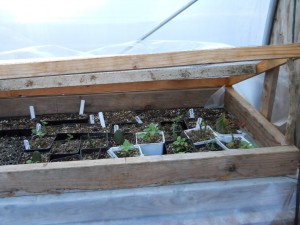 Hot Bed
Hot Bed
A hot bed is similar to a cold frame except there is some type of heating source, which helps to control the temperature inside. The heat can come from a number of different sources such as: incandescent light bulbs, electrical heating units, boiler steam, or even composting manure. Hot beds are a great way to start seedlings early in the spring.
One drawback to a hot bed is the soil must be checked often to make sure it isn’t drying out too quickly. If this happens, it can be hard for the seeds to germinate or for young seedlings to survive. The hot bed is typically used for this purpose only, and as the plants begin to grow they are then placed in a garden or other type of greenhouse.
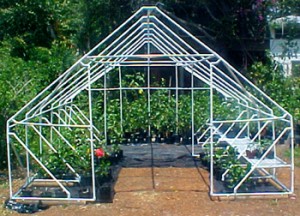 A-Frame
A-Frame
A-frame greenhouses are named because of their shape, which is the form of an ‘A’ in design. They are made of a simple construction with posts and rafters that are embedded.
This design allows for more space near the sidewalls and also provides excellent air circulation. It is easy to build and more permanent than other greenhouses. The A-frame is a sturdy design and works well in windy climates.
Drawbacks to the A-frame are that it takes much more building material for the supporting trusses, and therefore ends up costing more upfront.
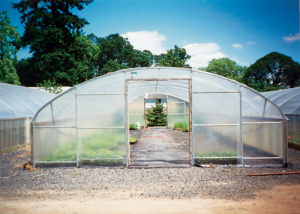 Quonset
Quonset
A quonset greenhouse has an arched roof which allows stress to be effectively transferred to the base. The quonset has the advantage of being cheaper to build than many other greenhouses.
Some quonsets are built with a lower ceiling, meaning users need to be short or may need to bend over. For the taller quonsets, the covers seem to rip more readily, making replacement costs something to consider.
Gothic
The gothic is also referred to as a gothic arch. It closely resembles a quonset except there is a point at the top. This point works well for people in snowy climates as the snow will just slide off and not accumulate which could cause the structure to weaken. The gothic is typically taller than a quonset, allowing for more headroom.
The gothic is much more difficult and time consuming to construct when compared to other greenhouses, but may be worth the time and effort in colder climates.
Gutter Connect and Free-Span
These types of greenhouses are used for growing things in bulk. The advantages are that it’s like having several greenhouses connected without walls separating them. There is a large, open area with plenty of room to grow many things.
Disadvantages to this are the expensive cost. These types of greenhouses are popular with people with lots of land or even businesses and aren’t really cost effective for a single family.
Some have seen this problem coming for a long time and changed their entire way of life by going off-grid. They have found alternative sources such as solar, wind and diesel to power their homes and machinery. A majority of us, who have not gone off-grid, are making a concerted effort to avoid dependence on this ailing infrastructure and preparing for life without it.
Greenhouse Gardening [Part 2]
A geodesic dome looks much like a ball cut in half. Due to its shape, the dome is durable and reliable. They are built to use maximum space while using the least amount of surface area. One benefit of the dome is that it allows the most amount of light to hit all points of the structure, unlike many other greenhouses which may have shady spots or hot spots. This structure also allows plenty of room for vertical growing.
While this is a superior type of greenhouse, there is one that is even more beneficial and it’s called the biodome.
Biodome
While biodomes come in the same shape as a geodesic dome, they are actually much better in a number of ways and the two shouldn’t be confused.
{adinserter backyardliberty}Biodomes are self contained ecosystems which are controlled to closely resemble a natural environment. An example of this is at the Montreal Biodome in which there are four different ecosystems that visitors can explore.
One is based on the South American rainforest, one on the North American wilderness, one on an estuary, and the last one on a polar area that has been divided into an Arctic side and a Antarctic side. This is done by keeping the inside of the biodome precisely controlled.
A biodome, once established, is able to be self sufficient and regenerate its own water and nutrients. There is no need for outside intervention once it is set up and running. However, the purpose of a biodome as a garden is to create the perfect environment for growing your own food source. Biodomes, when built large enough, can also play host to insects and animals.
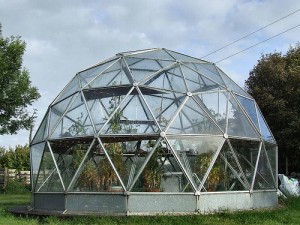 The benefits of owning a biodome are many and various. Using a biodome for growing food means you can have the perfect temperature and ‘season’ all year long. Unlike a traditional greenhouse, cucumbers and lettuce in the winter are no problem, and neither is cantaloupe in the spring.
The benefits of owning a biodome are many and various. Using a biodome for growing food means you can have the perfect temperature and ‘season’ all year long. Unlike a traditional greenhouse, cucumbers and lettuce in the winter are no problem, and neither is cantaloupe in the spring.
They save money when it comes to water and energy because the inside of the biodome is regenerative. When using a biodome to grow food, it is easy to determine the exact amount of growing time each different vegetable will need, giving growers the ability to plan exactly when to plant and harvest, making it easy to have enough of any given vegetable at any given time.
Seedlings that are grown in a biodome grow faster than those grown in a hot bed or by other methods. They are not only stronger, but more resilient as well. They can survive being transplanted to a garden easier, if sharing your plants with neighbors, friends, or family is something you’re considering. Biodomes are also good at keeping out bugs and viruses plants can become sick with. The biodome is designed to keep these things out.
In simple words, “The Miracle Farm ” is a step-by-step guide that outlines how to build a micro-farming system that will produce an unlimited supply of clean water and fresh food for many years without having to expend large amounts of money for materials or having to be too concerned with maintenance.
The outside of the biodome works much like the geodesic dome in that the sun will not overheat one area or be affected by shade. Plants don’t dry out or even get too much or too little of any given nutrient.
For those who are interested, the biodome can be used for both aquaponics and also for hydroponics. Biodomes are typically a little larger than other types of greenhouses, so in addition to being able to control the environment, there are many more options of how to use the biodome, some of which aren’t possible in one of the more conventional greenhouses. If space is an issue, a smaller sized biodome will work just as good as a large one.
When biodomes are built correctly, they can withstand a variety of environmental factors. Because of the way the biodome is structured, it is very strong and can withstand a lot of pressure. It is best if they are screwed in and bolted down to the ground, so they can even withstand small tornadoes and earthquakes. Many biodomes are builder friendly with simple construction and overall can be more cost effective than many greenhouses.
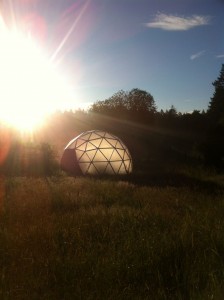 Biodomes, once unscrewed or unbolted from the ground, are portable and easy to move. Because of this, many cities and towns don’t require building permits as they are considered temporary structures, although it is important to check local building codes.
Biodomes, once unscrewed or unbolted from the ground, are portable and easy to move. Because of this, many cities and towns don’t require building permits as they are considered temporary structures, although it is important to check local building codes.
Biodomes have superior ventilation and are energy efficient due to their shape. Since heat rises, many greenhouses will stay hotter near the top.
With a biodome, the heat rises to the top, then naturally gets pushed down as more heat keeps rising, keeping the dome the same temperature year round.
A small window inserted at the top of the biodome allows excess hot air to vent, while the vent at the base of the biodome allows cold air in. This exchange keeps the air moving and continually fresh, making the inside of the biodome the perfect place to grow a variety of vegetables.
As people begin to realize how to get back to doing things the way they were for years, there is naturally a learning curve. Whether it’s learning to hunt, can, or even sew, it all takes time. Using a biodome to grow vegetables can decrease the learning curve exponentially when it comes to gardening and a family can be up and running with fresh produce in no time. As time and money are factors for many people, the biodome may be the perfect answer for families.
Biodomes are used by many people in countries all over the world, with great success. As times become harder, money tighter, and dependency on the grid ever more frightening, doing more things for ourselves becomes even more important. Learning about using heirloom seeds in the biodome can help to keep a garden up and running for years to come. Having a garden is a big step in being self sustaining, and knowing where the food is coming from.
Gardeners determine what chemicals come in contact with the food, whether or not to use GMO seeds, and other factors. Fresh, healthy produce is readily available year round, making the biodome the best option for most people.
This article has been written by Susan C. for Survivopedia.
Discover how to survive: Most complete survival tactics, tips, skills and ideas like how to make pemmican, snow shoes, knives, soap, beer, smoke houses, bullets, survival bread, water wheels, herbal poultices, Indian round houses, root cellars, primitive navigation, and much more at: The Lost Ways
The Lost Ways is a far-reaching book with chapters ranging from simple things like making tasty bark-bread-like people did when there was no food-to building a traditional backyard smokehouse… and many, many, many more!
Here’s just a glimpse of what you’ll find in The Lost Ways:
From Ruff Simons, an old west history expert and former deputy, you’ll learn the techniques and methods used by the wise sheriffs from the frontiers to defend an entire village despite being outnumbered and outgunned by gangs of robbers and bandits, and how you can use their wisdom to defend your home against looters when you’ll be surrounded.
Native American ERIK BAINBRIDGE – who took part in the reconstruction of the native village of Kule Loklo in California, will show you how Native Americans build the subterranean roundhouse, an underground house that today will serve you as a storm shelter, a perfectly camouflaged hideout, or a bunker. It can easily shelter three to four families, so how will you feel if, when all hell breaks loose, you’ll be able to call all your loved ones and offer them guidance and shelter? Besides that, the subterranean roundhouse makes an awesome root cellar where you can keep all your food and water reserves year-round.
Books can be your best pre-collapse investment.
The Lost Ways (Learn the long forgotten secrets that helped our forefathers survive famines,wars,economic crisis and anything else life threw at them)
Survival MD (Best Post Collapse First Aid Survival Guide Ever)
Conquering the coming collapse (Financial advice and preparedness )
Liberty Generator (Build and make your own energy source)
Backyard Liberty (Easy and cheap DIY Aquaponic system to grow your organic and living food bank)
Bullet Proof Home (A Prepper’s Guide in Safeguarding a Home )
Family Self Defense (Best Self Defense Strategies For You And Your Family)
Survive Any Crisis (Best Items To Hoard For A Long Term Crisis)
Survive The End Days (Biggest Cover Up Of Our President)
Drought USA (Discover The Amazing Device That Turns Air Into Water)

